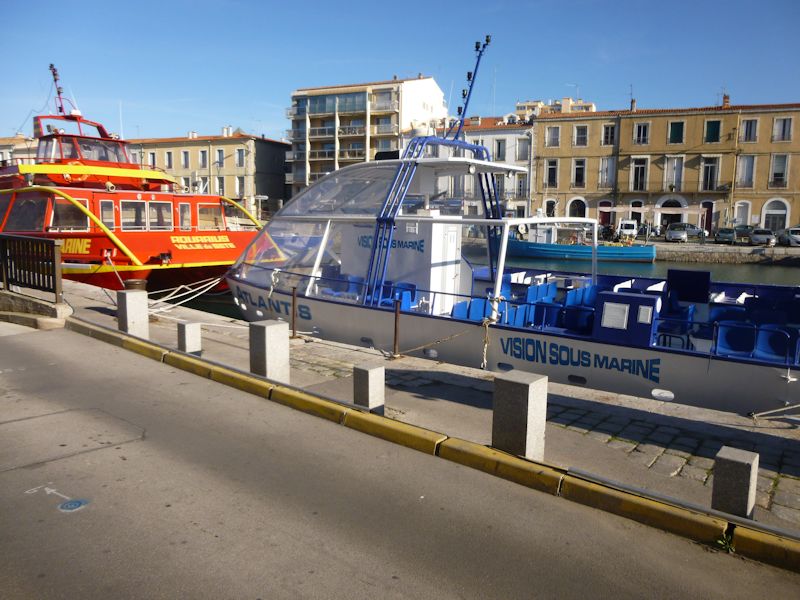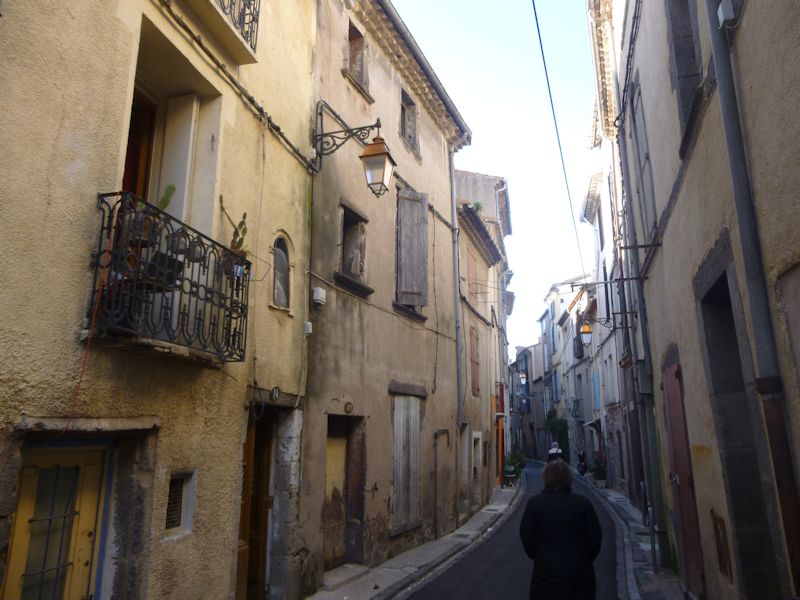You may not find this terribly rewarding unless you're included here, so this is a good time for casual and random browsers to turn back before they get too caught up in the sweep and majesty of the proceedings and can't let go.
We're enjoying the 30th of December 2014 with a
sunny drive down the Mediterranean coastline southwestward from Montpellier, and this is the thriving beach resort of Sète, the 'Venice of Languedoc'.

Sète is built all round Mont St-Clair, a rare bump on the coastal flatlands, with a network of canals connecting the town of 43,000 souls with the Mediterranean and with the huge lagoon, the Étang de Thau, famous for its oysters and mussels.

A peaceful scene in the off season, but in summer it's the venue for festivals of Water Jousting, wherein towns put forward their best rowers with an agile knight perched on the prow of their colorful boats, armed only with a lance, a shield, and unshakeable courage. Descendants of Roman naumachia games, the tournaments were revived in Aigues-Mortes by the idle Crusaders awaiting transport to the "Holy Wars" in 1270. The sport is presently regulated by the Federation of French Jousting and Water Rescue!

On the high street

Street scene

The Bar of the Old Port -- the Vieux Port with its lighthouse and mix of pleasure boats and commercial fishing boats. Acknowledging Sète's reputation for its oysters and mussels, Kristin is seizing the opportunity to help the local economy in one of the canal-side restaurants, and I have only to discover which one.

The site of Sète is mentioned from classical times but its development took off in the 17th century, as a port connected to the Canal du Midi, which linked the Atlantic via the Garonne river with nearby Agde, completed in 1681. The British apparently tried twice to capture the town, in 1710 and 1807, both times unsuccessfully, but the German army came along in November 1942 and had better luck, as usual. Luckily, the US Army Air Force was on hand to help out by bombing the train station, industries, and oil refineries in June 1944, so that was good.

Fishing rigs

And undersea sightseeing boats awaiting a change of season

A beautiful canal, and Paul Valéry was born here, too.

The Venice of Languedoc

'You are here' is the blue circle, and we're there. Or were.

But not for long -- we're moving on down the 10 or 12 kilometres of beaches between the sea and the lagoon to the old town of Agde, with its fortified cathedral.
Agde

Agde is a venerable city, a Phocaean Greek colony founded in 525 BC as a spillover from their first establishment in Marseilles in 600 BC. It was called Agathe Tyche, 'good luck', presumably meant in a hopeful rather than a sardonic sense, and the 23,000 locals are still called the Agathois.

We're mainly keen to see the famous black basalt fortified cathedral but we'll profitez from the occasion to walk round the old town whilst we're here.

The Place Jean Jaures

The banks of the river Hérault, near the end of its 150km journey down from the mountains of the Cévennes.

Surely not the cathedral; it's in fact the 17th century Bishop's Palace, renovated as the Hotel La Galiote, distinguished by its imposing antiquity and the worst TripAdvisor ratings and comments I've ever seen. A 'galiote' was a flat-bottomed barge pulled up the river by horses on the riverbank.

The Melrose Café specializes in 'Tex Mex Californian".

A fortified belltower and donjon, or keep; we're here.

The Cathédrale Saint-Étienne d'Agde, or St Stephen's Cathedral, was built beginning in 1173, replacing a Carolingian-era church from the 9th century, which in turn had been built over a 5th century Temple of Diana. Like most of the old monumental buildings in Agde, it's constructed of the black basalt from nearby quarries.

With its massive fortifications and keep, the cathedral is clearly meant to minister to the physical safety of the worthy churchgoers as much as to their spiritual edification. A good idea for any seaside town in the golden age of Mediterranean pirates.

The present entrance is through a Lady Chapel on the side, saved from the Romanesque cloister that was torn down in 1857, by a 'greedy entrepreneur', they say.

The spartan lady chapel at the entrance

A fairly attractive, simple Romanesque nave . . .

. . . with a 17th century high altar of multi-colored marbles, a huge organ, and a priestly guard coming on duty.

The cathedral was the seat of the diocese of Agde from the 6th century until the French Revolution, when the last bishop was guillotined in Paris during the Reign of Terror in 1794. In the concordat of 1801, the see, like others in the region, was incorporated into the diocese of Montpellier.

A trompe-l'oeil neighborhood

Inspired, and convincing


A last fascinating view of the cathedral neighborhood

A medieval market, part of the Mairie around the corner

Now we're seeking out the venerable Musée Agathois, deep in the old town

Somewhere near here, perhaps

Not yet

Even the Snack Bar locks up in the winter

The youngest rides her little pink bicycle back and forth across the balcony

Here it is, but closed. The Musée Agathois or Agde Museum was created in 1932 and installed in the charitable institution founded by the Bishop of Agde in 1699.

Down the Rue de la Poissonnerie (fishmarket street), towards the river

The Place de la Marine by the river Hérault

Congenial floating restaurants, awaiting summer . . .

. . . with the windows thrown wide open for a cool evening breeze. Oh well.

Riverside scenes

The riverfront side of the Cathedral of St-Stephen

Vous êtes ici, and we were, then.
Zoom upriver: The Château Laurens on Belle Isle, built in 1900, where the Canal du Midi joins the river Hérault.
 Dwight Peck's personal website
Dwight Peck's personal website

















































